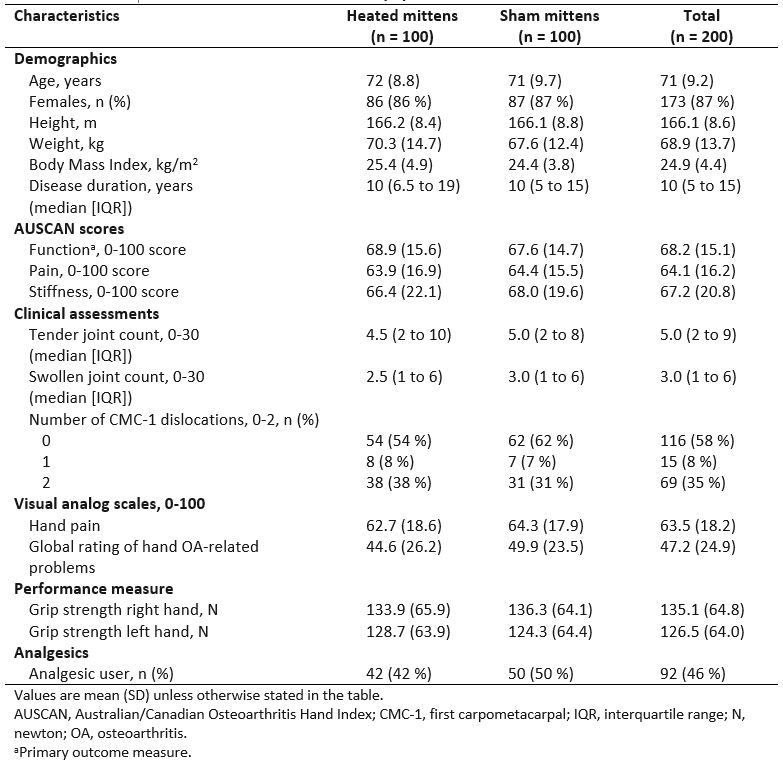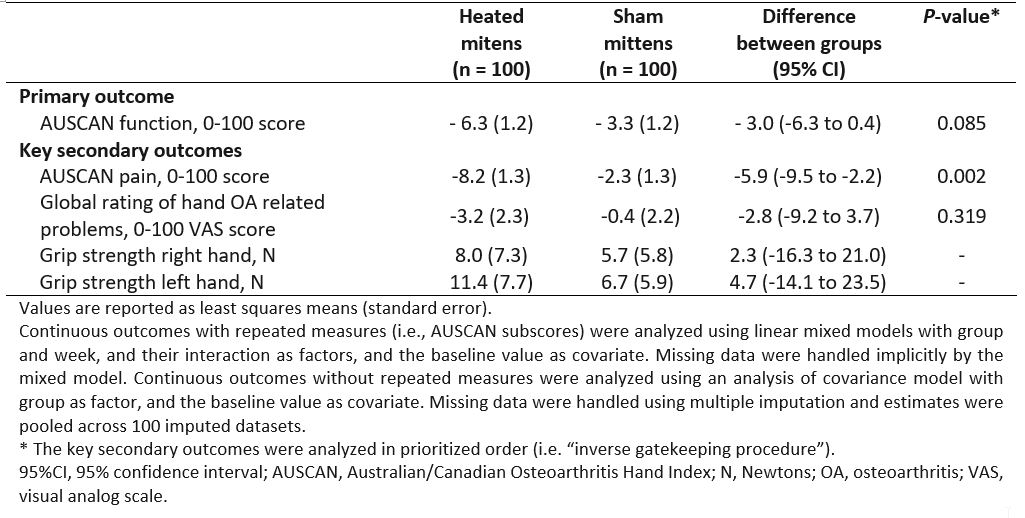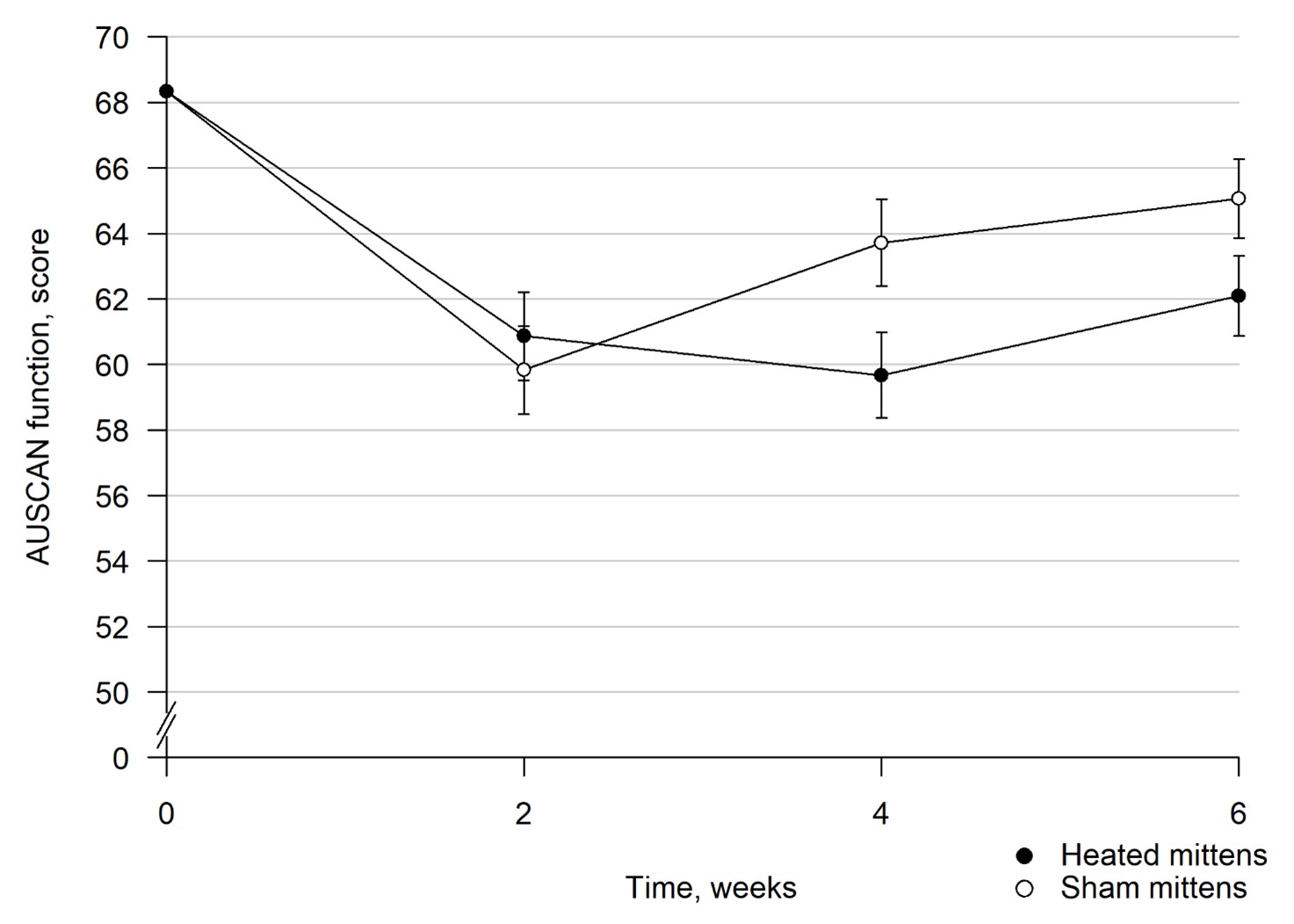Session Information
Session Type: Poster Session C
Session Time: 9:00AM-11:00AM
Background/Purpose: Hand Osteoarthritis (OA) is common and causes pain and disability. Heat is anecdotally known to moderate symptoms and is conditionally recommended as a treatment for Hand OA by the American College of Rheumatology.
The purpose was to assess change in function after 6 weeks treatment with electrically heated mittens compared to sham mittens (electrical heating disabled) in participants with hand OA.
Methods: We performed a randomized superiority trial evaluating the potential benefit of heated mittens vs sham mittens during a 6-week trial period. We included participants diagnosed with hand OA according to the American College of Rheumatology classification criteria who had an AUSCAN (Australian/Canadian Osteoarthritis Hand Index) function of ≥ 40 on a 0-100 scale (higher scores indicate worse function). Participants were recruited from October 2020 to January 2023 and participated during the winter season (October to April 2020/21, 2021/22, 2022/23) in Denmark. Participants were randomly allocated (1:1) to heated mittens or sham mittens. The mittens appeared identically, including LED-lights that led when the heat function was activated. In the sham mittens, the heating was disabled. Participants were instructed to wear the mittens at least 15 minutes per day for 6 weeks. The primary outcome was change in AUSCAN function at week 6. Key secondary outcomes included AUSCAN pain, visual analog scale (VAS) global assessment of hand related problems, and grip strength. All analyses were based on the Intention-to-treat population, with continuous data modelled using repeated measures, mixed effects models adjusted for baseline variables.
Results: Two hundred participants were randomized to heated mittens (n = 100) or sham mittens (n = 100); 91 (Heat) and 95 (Sham) participants, completed the trial. The mean age was 71 years, 87 % were women, and median disease duration was 10 years (see Table 1). The mean (SE) change from baseline to week 6 in the AUSCAN function was -6.3 points (1.2) in the Heat group, and -3.3 points (1.2) in the Sham group, corresponding to a group difference of -3.0 points (95%CI, -6.3 to 0.4; P = 0.085; see Figure 1 and Table 2). Key secondary outcomes showed a statistically significant difference in AUSCAN pain of -5.9 points (95%CI, -9.5 to -2.2; P = 0.002), while no significant differences were found for VAS global assessment of hand related problems (0-100 VAS score) or grip strength.
Conclusion: Heated mittens were not superior to sham-heated mittens after 6 weeks regarding AUSCAN function but improvement in hand pain was observed.
To cite this abstract in AMA style:
Bartholdy C, Døssing A, Stisen Z, Nielsen S, Bliddal H, Christensen R, Henriksen M, Ellegaard K. Heated Mittens for Patients with Hand Osteoarthritis: A Randomized Trial [abstract]. Arthritis Rheumatol. 2023; 75 (suppl 9). https://acrabstracts.org/abstract/heated-mittens-for-patients-with-hand-osteoarthritis-a-randomized-trial/. Accessed .« Back to ACR Convergence 2023
ACR Meeting Abstracts - https://acrabstracts.org/abstract/heated-mittens-for-patients-with-hand-osteoarthritis-a-randomized-trial/



